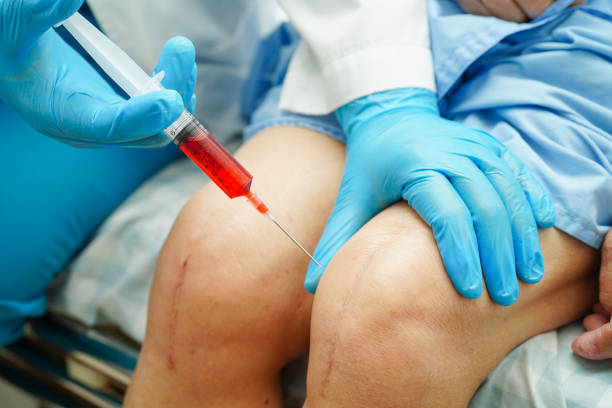Fluid on knee 2 years after knee replacement can be alarming for many patients. This condition can cause discomfort, pain, and decreased mobility, impacting one’s quality of life.
According to Dr. Sandeep Singh, “Patients experiencing fluid on knee 2 years after knee replacement surgery should not ignore it. This could be a sign of underlying issues such as implant loosening or infection. This requires prompt medical attention to prevent further complications.”
Dr. Sandeep Singh is a seasoned orthopedic doctor in Bhubaneswar. He has over 15 years of experience and specializes in limb reconstruction, joint replacement, ACL reconstruction, fractures, and knee replacement in Bhubaneswar. His extensive knowledge and expertise provide valuable insights into addressing fluid build-up. This ensures patients receive the best care possible.
Experiencing knee discomfort post-surgery? Book your appointment with an orthopedic surgeon today to get personalized advice and treatment.
What Causes Fluid on Knee 2 Years After Knee Replacement?

Fluid on knee 2 years after knee replacement surgery can be due to several factors. Here are some potential causes:
- Infection:Even years after surgery, infections can occur and cause fluid accumulation.
- Implant Issues:Problems with the knee implant can lead to inflammation and fluid build-up.
- Overuse:Excessive use or stress on the knee can result in swelling.
- Bursitis:Inflammation of the bursae, small fluid-filled sacs around the knee, can cause fluid accumulation.
- Arthritis:Development of arthritis in the surrounding joints can contribute to fluid build-up.
- Loose Bodies:Fragments of bone or cartilage can cause irritation and swelling.
Concerned about what causes fluid on knee after knee replacement? Consult with an orthopedic expert to explore effective treatments and prevent complications.
Symptoms of fluid on knee 2 years after knee replacement
- Persistent swelling around the knee joint
- Pain or discomfort in the knee, especially when moving or putting weight on it
- Stiffness in the knee, making it difficult to bend or straighten
- Warmth or redness around the knee area
- Limited range of motion
- A feeling of tightness or pressure in the knee
- Increased difficulty in performing everyday activities like walking or climbing stairs
- Occasional clicking or popping sounds from the knee joint
- A sensation of instability or weakness in the knee
- Visible fluid accumulation, often appearing as a bulge or puffiness around the knee
How Do You Get Rid of Fluid on knee 2 years After Knee Replacement?

Managing and reducing fluid build-up after knee replacement involves several strategies:
- Rest and Elevation:Reducing activity and keeping the leg elevated to decrease swelling.
- Ice Therapy:Applying ice packs to the affected area to alleviate inflammation.
- Compression:Using compression bandages or wraps to control swelling.
- Medication:Taking prescribed anti-inflammatory drugs or pain relievers.
- Aspiration:Removing excess fluid through needle aspiration performed by a healthcare professional.
- Physical Therapy:Engaging in physical therapy exercises to strengthen the knee and improve mobility.
- Hydration:Staying adequately hydrated to support overall health and recovery.
- Diet:Maintaining a healthy diet rich in anti-inflammatory foods.
- Avoiding High-Impact Activities:Limiting activities that put excessive strain on the knee.
Struggling with knee pain 2 years after replacement surgery? Book your appointment with an expert orthopedic doctor for effective management strategies.
Exercises to Perform 8 Weeks After Knee Replacement

Several treatment options can address fluid accumulation on the knee:
Revision Surgery: Replacing or repairing the knee implant to address issues causing inflammation and fluid buildup.
Synovectomy: Removing the inflamed synovial membrane to reduce fluid production and alleviate symptoms.
Corticosteroid Injections: Injecting corticosteroids directly into the knee to reduce inflammation and pain.
Aspiration: Using a needle to remove excess fluid from the knee joint to relieve pain and swelling.
Antibiotics: Prescribing antibiotics to treat infections causing fluid buildup in the knee.
Experiencing knee issues after surgery? Consult with an orthopedic surgeon for tailored treatment options and regain your mobility.
How Can You Prevent Fluid Build-Up on the Knee Post Surgery

Preventing fluid build-up involves proactive measures:
- Follow Post-Op Instructions:Adhering to recovery guidelines provided by the surgeon.
- Stay Active:Engage in low-impact exercises to maintain knee health.
- Avoid Overuse:Prevent excessive strain on the knee.
- Healthy Diet:Maintain a balanced diet to support healing.
- Monitor for Symptoms:Watch for signs of swelling or pain.
- Regular Check-Ups:Schedule follow-ups with your doctor.
- Weight Management:Keep a healthy weight to reduce stress on the knee.
Looking to prevent knee complications after surgery? Book your appointment with an orthopedic expert for personalized advice and support.
Conclusion
In conclusion, experiencing fluid on knee 2 years after knee replacement can be concerning, but understanding the symptoms and seeking timely medical advice is crucial.
With the expertise of professionals like Dr. Sandeep Singh, a reputable orthopedic doctor in Bhubaneswar, patients can navigate these challenges and ensure their long-term knee health. Always prioritize your well-being and consult with a specialist if you notice any persistent issues.
FAQs
What causes fluid on the knee 2 years after knee replacement?
Fluid on the knee after knee replacement can be caused by infection, implant loosening, inflammation, or mechanical issues with the knee joint.
Can you get fluid in your knee after a knee replacement?
Yes, it is possible to develop fluid in your knee after a knee replacement due to various factors like inflammation or infection.
What is the best way to get rid of fluid on the knee?
The best way to get rid of fluid on the knee is through methods like rest, ice application, compression, and in some cases, aspiration by a healthcare professional.
What complications can arise from untreated knee fluid?
Untreated knee fluid can lead to complications such as increased pain, reduced mobility, and potential infection or damage to the joint.
Can knee fluid be a sign of prosthetic failure?
Knee fluid can be a sign of prosthetic failure, especially if associated with pain and instability, indicating issues like loosening or wear of the implant.

